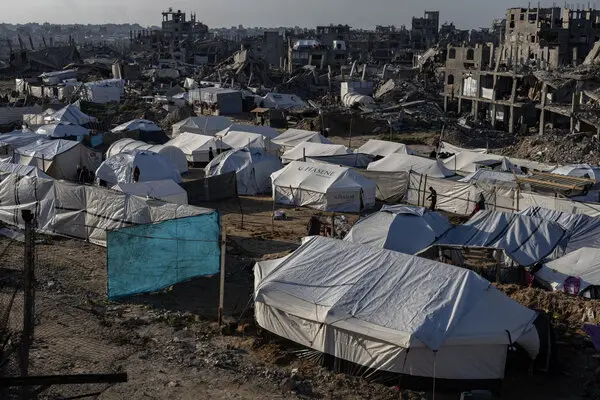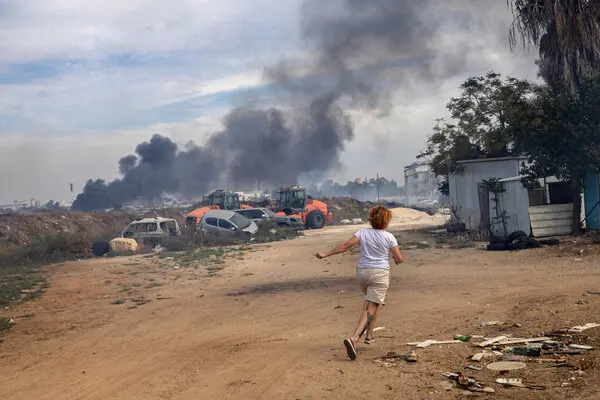The Justice Department began its case by telling the jury that five members of the far-right pro-Trump group had led scores of others in a coordinated attack on the Capitol on Jan. 6, 2021.
-
Send any friend a story
As a subscriber, you have “>10 gift articles to give each month. Anyone can read what you share.
Give this articleGive this articleGive this article

The trial of Enrique Tarrio and his four co-defendants for seditious conspiracy is another major case in the Justice Department’s investigation of the Capitol attack.
Encouraged by former President Donald J. Trump, five members of the Proud Boys led scores of others in the far-right group in a coordinated attack on the Capitol on Jan. 6, 2021, using violence at key moments during the assault to disrupt what prosecutors described on Thursday as “the heart of our democracy”: the lawful transfer of presidential power.
In their opening statement at the seditious conspiracy trial of the five Proud Boys, prosecutors sought not only to place the extremist group at the center of the riot at the Capitol, but also to tie it directly to Mr. Trump — a figure whom the organization has revered for years.
During their 90-minute presentation in Federal District Court in Washington, the prosecutors told the jury how several members of the Proud Boys — including their leader at the time, Enrique Tarrio — were inspired by Mr. Trump’s own words to descend on Washington on Jan. 6 for a “wild” protest.
The prosecutors said that by following his call, the group cemented a relationship that had intensified in the weeks leading up to the 2020 election, when Mr. Trump famously asked the Proud Boys to “stand back and stand by.”
“These men were calling for war if their preferred candidate was not elected,” said Jason McCullough, the lead prosecutor in the case. “These men did not stand back, they did not stand by. Instead, they mobilized.”
The trial of Mr. Tarrio and his four co-defendants — Joseph Biggs, Ethan Nordean, Zachary Rehl and Dominic Pezzola — was the latest landmark in the Justice Department’s investigation of the Capitol attack, an inquiry that has so far led to more than 950 arrests and could result in another 1,000 people being charged.
Only two other Jan. 6-related trials have included charges of seditious conspiracy, the most serious count the government has brought in its Capitol riot cases.
Understand the Events on Jan. 6
- Timeline: On Jan. 6, 2021, 64 days after Election Day 2020, a mob of supporters of President Donald J. Trump raided the Capitol. Here is a close look at how the attack unfolded.
- A Day of Rage: Using thousands of videos and police radio communications, a Times investigation reconstructed in detail what happened — and why.
- Lost Lives: A bipartisan Senate report found that at least seven people died in connection with the attack.
- Jan. 6 Attendees: To many of those who attended the Trump rally but never breached the Capitol, that date wasn’t a dark day for the nation. It was a new start.
At the first of those trials, Stewart Rhodes, the leader of the Oath Keepers militia, another far-right group, was convicted of sedition along with one of his lieutenants. The second sedition trial, involving four other Oath Keepers, is taking place in a courtroom just down the hallway from the Proud Boys trial.
In their own opening statements, lawyers for Mr. Tarrio and the others echoed the defense that Mr. Rhodes used during his trial, telling the jury that the Proud Boys had no plan in place on Jan. 6 to storm the Capitol. Any violence that day, the lawyers said, was spontaneous — a fact, they added, that would be confirmed by the government’s own witnesses.
“You will see impeachment evidence showing that over and over and over and over, the government has been told by witnesses that there was no plan for Jan. 6,” said Nicholas Smith, a lawyer for Mr. Nordean.
The sedition trial of Mr. Tarrio and his subordinates represents an inflection point for the Proud Boys. While prosecution has essentially dismantled the group’s leadership and weakened its capacity for large-scale protests, in recent months the group has switched tactics and taken part in attacks on L.G.B.T.Q. events around the country. Several members have also run for local office.
Much like the Oath Keepers, the Proud Boys took part in two pro-Trump rallies in Washington even before Jan. 6, marching in support of Mr. Trump’s false claims that the voting had been marred by widespread fraud.
A pivotal moment for Mr. Tarrio and the others occurred at one of these rallies — the so-called Jericho March on Dec. 12, 2020. After nightfall, a contingent of Proud Boys pulled down a Black Lives Matter banner from a local church and burned it in the street. In a confrontation that night with leftist counterprotesters, Jeremy Bertino, a North Carolina Proud Boy, was stabbed.
Even though the Proud Boys had a long history of close relations with the police, the attack on Mr. Bertino — and the fact that Mr. Tarrio was soon under investigation for the banner burning episode — served to turn the group against law enforcement, Mr. McCullough said.
Still enraged, the Proud Boys paid close attention one week later when Mr. Trump summoned his supporters to Washington on Twitter for a “wild” protest on Jan. 6. Answering the call, prosecutors said, Mr. Tarrio and lieutenants like Mr. Biggs put together a handpicked group of “real men” — known as the Ministry of Self-Defense — to lead their efforts on the ground that day.
“The time for standing back and standing by was over,” Mr. McCullough said, “and it was time to mobilize.”
Prosecutors will argue during the trial that Proud Boys leaders like Mr. Tarrio — whose subsequent arrest in the banner burning kept him out of Washington on Jan. 6 — incited their own troops and other, more ordinary “normies” in the mob into battle at the building.
To tell that story, prosecutors intend to show the jury video clips of the attack. Among them will be many that depict members of the Proud Boys breaching barricades outside the building, shattering windows and scuffling with officers.
Prosecutors are also expected to offer testimony from Mr. Bertino, who was at home that day tending to his wounds and watching the attack through a live video feed. The government is likely to call other Proud Boys who have pleaded guilty and turned on their compatriots. Those could include John C. Stewart, a Pennsylvania man who was not at the Capitol but helped lead people to the building from afar, and Charles Donohoe, a former Marine from North Carolina who was central in the Proud Boys’ charge.
In a series of pretrial rulings, Judge Timothy J. Kelly, who is overseeing the trial, allowed prosecutors to introduce evidence of some of the Proud Boys’ racist tendencies. Apparently seeking to rebut such things in advance, Sabino Jauregui, Mr. Tarrio’s lawyer, told the jury that the group welcomed Black and Jewish people — and even had a rabbi as a member.
“The Proud Boys are basically a drinking club,” Mr. Jauregui said, employing a euphemism often used by the group. “Contrary to what you’ve heard, the Proud Boys are not a racist, sexist, homophobic organization.”
Mr. Jauregui also sought to blame Mr. Trump for the violence at the Capitol.
“President Trump told these people that the election was stolen,” he said. “Trump told them to go there on Jan. 6. And it was Trump in his speech on Jan. 6 that unleashed this mob toward the Capitol.”
Still, the defense’s chief trial strategy will be to attack the government’s witnesses — often with statements they made to prosecutors during the long investigation of the case.
As Mr. Smith told the jury on Thursday, Mr. Stewart at one point explained to the F.B.I., “For the record, we did not ever preplan any attack or breach of the Capitol building. It was just a protest.”
The defense may also call several F.B.I. informants who were secretly embedded in the Proud Boys in the months leading up to Jan. 6 — including some who were on the ground as the Capitol was being stormed.
One of these informants, Mr. Smith said, was texting with his handler even as the mob attacked the building.
“PB did not do it nor inspire,” the text, which was shown to the jury, read. “The crowd did it as a herd mentality. Not organized.”
Source: nytimes.com



